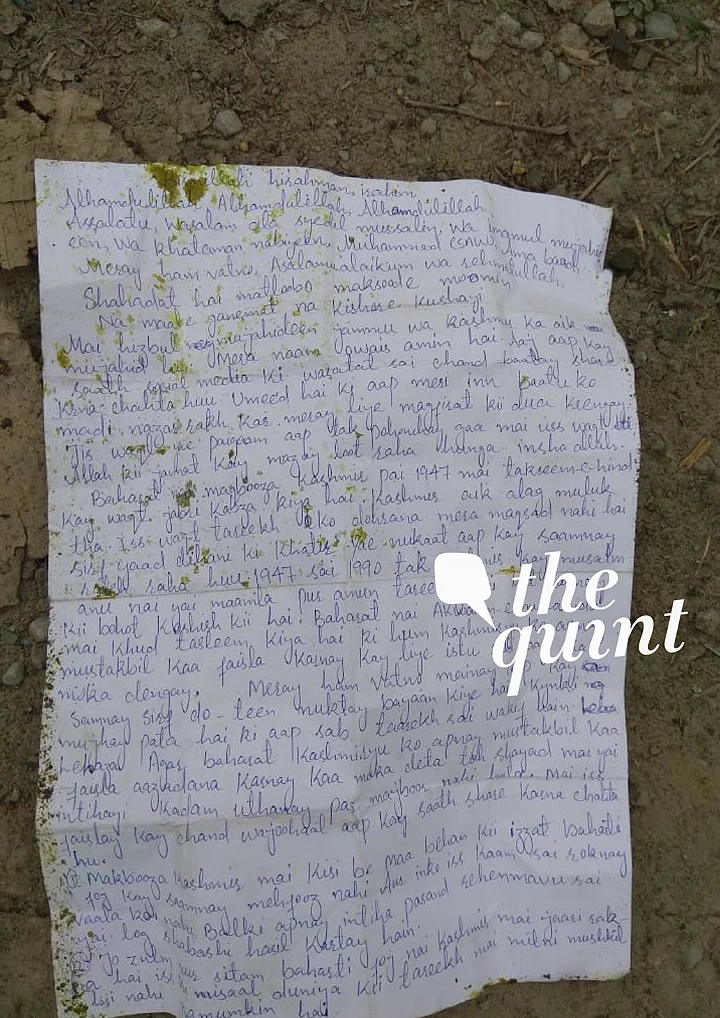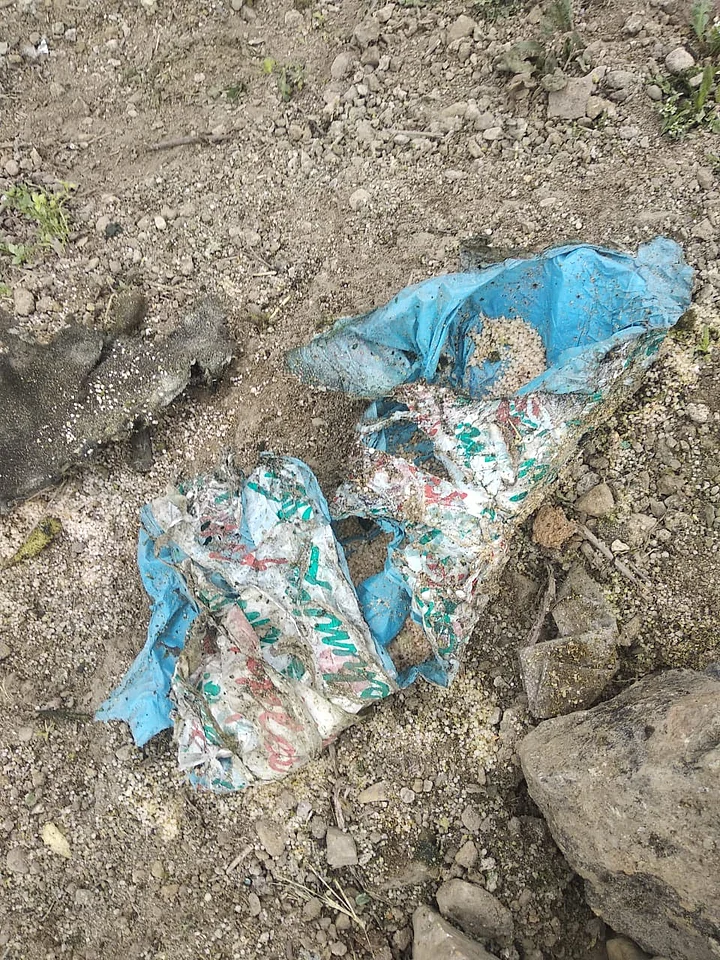A two-page suicide note, purportedly written and dropped by a Hizbul Mujahideen bomber and exclusively accessed by The Quint, makes it clear that the car blast near the Banihal Railway Station on Srinagar-Jammu highway, on Saturday 30 March, was an attempt to repeat the infamous Pulwama fidayeen attack on the Central Reserve Police Force (CRPF).
It failed—not because of meticulous surveillance by security and intelligence agencies but due to the good luck of the ten personnel on board the targeted bus in the middle of a 46-vehicle Srinagar-Jammu convoy.
More than forty CRPF men had been left dead in the 14 February strike at Lethapora, Pulwama, that virtually brought India and Pakistan to the point of war as, for the first time after 1971, the Indian Air Force crossed the LoC on 26 February and strafed the Jaish-e-Mohammed installation at Balakot in Khyber Pakhtunkhwa province of Pakistan. There was retaliation from Pakistan on 27 February that, however, ended with repatriation of the seized IAF pilot Abhinandan.
Breach of Post-Pulwama MHA Guidelines
With the strategic and security experts debating the ‘deterrent’ in television news studios, indigenous terror outfit Hizbul Mujahideen seems to have meticulously planned a repetition of the Pulwama blast.
A Hyundai Santro plying along the convoy overtook a number of vehicles in the convoy and caught fire with a low-intensity blast. Eyewitnesses spotted a suspected militant jumping out of the burning Santro and fleeing towards a hamlet. The windshields of a bus suffered mild damage, yet nobody was killed or injured.
“Today, I want to share something with you all through social media. I hope you will appreciate my feelings and pray for me. By the time this message from me will reach you, I will be enjoying my arrival in Allah’s Jannat,” Owais Amin, who was supposed to die much like Adil Dar of Pulwama, recorded in the note. As his car failed to blow up with the primary blast, he escaped and got a fresh lease of life.
Recent Provocation: Rizwan’s Custodial Killing
The suicide note in Urdu, but written in English transliteration, identifies the bomber as Owais Amin. It selectively refers to the history of the UN resolutions on Kashmir, paints India as a ‘tyrant occupier’ and claims that failure to hold Plebiscite in Kashmir had driven many of the Kashmiris, including Owais Amin, to ‘extremism’.
Of the recent stimulants, it mentions alleged custodial killing of a private school teacher Rizwan Assad Pandit who died in police custody on 19 March when he was under interrogation for his alleged involvement in the Lethapora blast.
“I want to know from the sensible Indian people as to why Rizwan Assad Pandit was martyred. He had neither touched a gun nor gone to across the border. He was an innocent Kashmiri youth. This is why I preferred death to life and I hold it as my good luck. A Muslim should live like Sultan Saladin Ayyubi (the 12th century Muslim military expedition hero who defeated Crusaders in a series of wars). A dignified life of few years is better than a jackal’s life of hundred years,” the note reads.
Adil Dar, the driver of the Pulwama strike who belonged to Jaish-e-Mohammed, had also left a similar message for the Kashmiris, recorded in an audio clip that went viral on social media after his death.
Before that, the only such message from a Kashmiri fidayeen militant had come out on 1 January 2018 when Fardeen Khanday of Tral died in an attack on a CRPF camp in Awantipora. “By the time, this message will reach you, I will be enjoying my arrival in Allah’s Jannat,” each one of them had said.
Director General of Jammu and Kashmir Police Dilbag Singh, however, maintained that the investigating agencies were still verifying veracity of the purported suicide note. He said that the experts, who were part of an elite team headed by DIG Doda-Ramban Bhim Sen Tuti, were examining witnesses and analysing the material seized from the spot. He said that the NIA team had visited the spot and they were “very much on the job”.
“One prominent militant by the name of Owais Malik exists in South Kashmir. But we are yet exploring if it was the same militant or a different one or neither who had caused the blast yesterday and escaped,” DGP said. Inspector General of Police, Jammu, MK Sinha, spoke to this correspondent upon landing of his helicopter in Banihal on Sunday. “I have reached with a team and it will take us two hours to make an inspection and have a meeting,” he asserted, without sharing details of the investigation.
Crucial CCTV Footage Obtained
DGP Singh revealed to The Quint that the police had succeeded to obtain a private video that identifies the Santro following the CRPF convoy towards Banihal. The official CCTVs installed at Jawahar Tunnel do not show any suspected vehicle following the convoy from Srinagar side.
To a great extent, it also identifies its driver. We observed that it was plying with a J&K number-plate which turned out to be fake. Thereafter, we took out its chassis number. The owner of the vehicle of that chassis number surfaced in Hisar, Haryana. We verified his antecedents but found nothing amiss. Now, we have taken out the Santro’s engine number that, we are sure, can lead us to its owner and must help us identify the terrorist. I am sure we will achieve a breakthrough soon.DGP Singh to The Quint
According to IGP Sinha, the Santro car was fitted with two LPG cylinders—one big and small—and contained petrol, jerrycan, gelatin sticks, urea and sulphur, the material which is used for fabricating Improvised Explosive Device (IED) to cause a blast.
The commander of the CRPF convoy, SS Yadav, whose area of operation falls in Banihal area of Srinagar-Jammu highway, was heard sharing with another officer that the material found in a sack was a low-combustion explosive. He was not clear whether it was RDX or urea. However, many officers believed it was loose urea that failed to burn the bus.
The DGP revealed there were two IEDs in separate tiffin carriers in the car. One of them went off. However, the car caught fire and it failed to detonate other IEDs.
We have seized a live IED in a tiffin carrier. It had caught fire but did not go off. Besides, there was one small LPG cylinder and one commercial LPG cylinder in the car. The main blast did not take place. It was sheer good luck of the targeted personnel that all the blasts did not occur simultaneously as per the terrorists’ plan.DGP Singh to The Quint
The DGP disclosed that the suicide bomber had overtaken seven to eight vehicles and attempted to hit a bus in the middle of the convoy. He admitted that it was a major security lapse for which all the responsible agencies, particularly the CRPF that escorts the convoys and provides Road Opening Parties (ROPs) on the highway, would be made accountable.




